Inflight Magazine of Brussels Airlines
Welcome to the Inflight Magazine of Brussels Airlines
In India
Text Tabitha Lasley, Karen Carmichael
A round-up of travel news from Brussels Airlines’ exotic destinations
Hotel with a view THE OBEROI AMARVILAS, AGRA
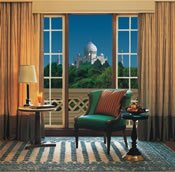 Where is it? Taj East Gate, Agra, India (, oberoihotels.com).
Where is it? Taj East Gate, Agra, India (, oberoihotels.com).
What’s the view? Every room looks right out at the Taj Mahal, which stands just 600 metres away. If you book into a suite or premier room, your view will be prettily framed in a large, arched window.
What to expect Rooms here are swooningly romantic, done out in Burmese teak, Greek marble and granite, and suites come with handmade furniture and four poster beds. The hotel is surrounded by nine acres of landscaped grounds, punctuated by pavilions and reflection pools.
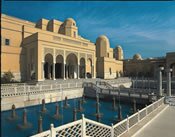 What you need to know There’s a red sandstone restaurant serving authentic Mughlai food, a fantastic spa offering traditional treatments like the rose sandalwood wrap, and a bar which enjoys the distinction of being the only one in the world with an interrupted view of the Taj.
What you need to know There’s a red sandstone restaurant serving authentic Mughlai food, a fantastic spa offering traditional treatments like the rose sandalwood wrap, and a bar which enjoys the distinction of being the only one in the world with an interrupted view of the Taj.
Why go there? Because you won’t get better views of the Taj Mahal anywhere else in Agra. And once you’ve tired of gazing at the Taj, the perfectly preserved ‘ghost city’ of Fatehpur Sikri is only an hour’s journey away. Nearby Ferozabad is famous for its beautiful glassware, while the Chambal Wildlife Sanctuary, home to crocodiles, alligators, nilgai (blue antelope), turtles and rare Gangetic dolphins, is just 90km from here.
What does it cost? Low season, short-stay packages start at €675 for a double room, for two nights including dinner in the restaurant and breakfast.
What does it cost? Low season, short-stay packages start at €675 for a double room, for two nights including dinner in the restaurant and breakfast.
Treat yourself
 Roughly translating as ‘the knowledge of life’, ayurveda is a Hindu philosophy practiced throughout India, which focuses on harmonising mind, body and spirit through healthy living. If you’re in Delhi, you should make time to visit an ayurvedic clinic, where medicated oils, leaves and massage are used to combat illness, stave off fatigue and aid relaxation.
Roughly translating as ‘the knowledge of life’, ayurveda is a Hindu philosophy practiced throughout India, which focuses on harmonising mind, body and spirit through healthy living. If you’re in Delhi, you should make time to visit an ayurvedic clinic, where medicated oils, leaves and massage are used to combat illness, stave off fatigue and aid relaxation.
And if you’re looking to recreate the experience at home, Delhi-based skin care company Kama’s line, founded on ayurvedic principles and made with organic plants and herbs like coriander, fennel and turmeric, is a good one to go for.
As concerned with the state of your soul – all products come in recyclable packaging and contain no animal products – as your skin, Kama donates a portion of its profits to local charities.
Try their Miraculous Beauty Fluid (€47), made with saffron, sandalwood and vetiver, which boosts radiance and smoothes fine lines. kamaayurveda.com, www.purenatural.eu
In the news
 There’s a lot to see around the Golden Triangle, that relatively small circuit that spans Delhi, Agra and Jaipur – once you’ve covered off the three cities, there are desert forts, deserted palaces, Ranthambore National Park and the sweeping sands of rustic Rajasthan to contend with. If you’re only here a short time, the best way to pack in as much as possible is to book with a tour guide. Some of the best are run by Jetair Tours, who do tailored trips around the area, taking in everything from elephant-back rides to the Amber Fort and rickshaw rides round Old Delhi to cosseting holistic treatments in Jaipur.
There’s a lot to see around the Golden Triangle, that relatively small circuit that spans Delhi, Agra and Jaipur – once you’ve covered off the three cities, there are desert forts, deserted palaces, Ranthambore National Park and the sweeping sands of rustic Rajasthan to contend with. If you’re only here a short time, the best way to pack in as much as possible is to book with a tour guide. Some of the best are run by Jetair Tours, who do tailored trips around the area, taking in everything from elephant-back rides to the Amber Fort and rickshaw rides round Old Delhi to cosseting holistic treatments in Jaipur.
In words
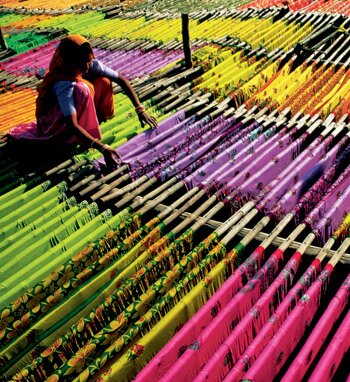
After being dyed, printed and made colour-fast, five-metre-long saris are hung out to dry under the Indian sun
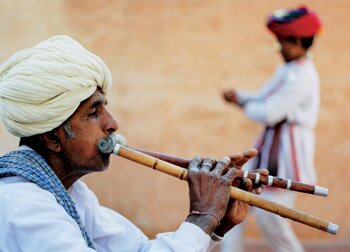
A musician playing traditional Indian instruments in Jaisalmer, Rajasthan, north-west India
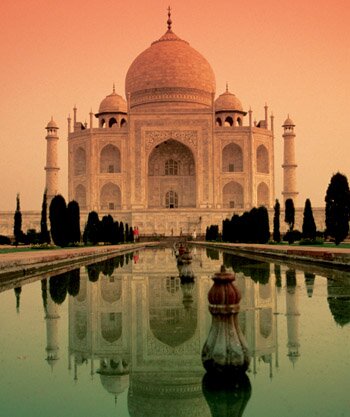
India’s most famous landmark, the Taj Mahal in Agra, was built by Shah Jehan in memory of his favourite wife Mumtaz Mahal and was completed in 1648
Text Tabitha Lasley
Images Corbis, Richard Bence
Delhi is not only a world-class city but also a launchpad for some of India’s greatest attractions
reasons to…visit Delhi

Traditional dress and jewellery
epitomise the rich layered history
of old India 1 It’s where new and old India go head to head
The capital is where the brave new face of industrial India collides with the richly layered history of the old country. Seeing the controlled chaos of contemporary Delhi come face to face with the oriental grandeur of the old town is a heady experience. This month, Indian Independence Day (15 August) sees some spectacular parades wind their way down the city’s main boulevard, Rajpath.
2 It’s got great shopping
You can’t see Delhi without seeing Chandni Chowk. Once the richest bazaar in East Asia, this riotously colourful street market still teems with life. Pick up silks, muslin, silver, saris, semi-precious jewels, delicately embroidered bags, sweets and street food here. But you should also make time to visit Connaught Place, Delhi’s largest mall, home to lots of big labels and high-street favourites.
3 And some amazing architecture
Islamic and Hindu culture have coexisted side by side here since the 1192 invasion of Muhammed of Ghor, as visibly evinced by the city’s unique Indo-Islamic architecture. Must sees include Qwwat-ul-Islam, Delhi’s first mosque, Jami Masjid, its largest, Quatab minar, India’s tallest tower and the huge 17th-century Red Fort.

Sambar deer can be found
grazing at Ranthambore
National Park 4 Its rich cultural heritage
Delhi is a fascinating cultural cross-section – although predominantly Hindu, it’s also home to Islamic, Jain, Sikh and Christian communities – so expect to see sacred cows strolling down the city’s main thoroughfares, past grand domed mosques and steeply terraced Jain temples. Venture outside the city walls and you’ll see the famous blue-doored Brahman houses of Rajasthan.
5 The tiger trail
It would be severely remiss to come to Rajasthan and not even attempt to see its most exotic inhabitant – the reclusive Bengal tiger. There are big two national parks within shouting distance of Delhi, and both are prime tiger-spotting territory. You’ll also see leopards, elephants and foxes at Jim Corbett National Park, while Ranthambore can lay claim to jackals, mongooses and sambar deer. And there are plenty of places to stay on Ranthambore –choose from more than 10 hotels and resorts.
6 The seventh wonder of the world isn’t far
Just 200km from Delhi is the city of Agra, made famous by the Taj Mahal. Built 500 years ago by fifth Mughal emperor Shah Jehan in memorial of his wife Mumtaz Mahal, the white marble mausoleum is a stunning testament to enduring love, and still considered the best example of Mughal architecture in the world. While you’re here, you can also see the Agra Fort, a red sandstone fortress that was home to the Mughal dynasty for centuries.
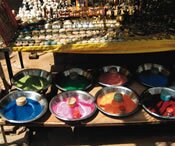
An explosion of colour lines the
market stalls in the form of
spices
7 You’ll see Fatephur Sikri
Situated 40km west of Agra, the walled city of Fatephur Sikri contains a meticulously preserved Mughal palace, ostensibly abandoned in 1586 due to a lack of water. The palace has remained perfectly intact, an exquisitely proportioned folly that few people fail to be bowled over by.
8 As well as Jaipur
Jaipur is the final point of the Delhi-Agra-Jaipur ‘Golden Triangle’. Depending on which story you believe, it’s either known as the ‘Pink City’ because one time resident Sawai Jai Singh decreed that the glare from the walls was too harsh, and wanted them a more muted shade of salmon, or because they were painted in honour of the Prince of Wales’ 1876 visit. Once seat of the Kachwaha dynasty, the city retains a sense of regal elegance, and is famous for its lavish palaces, the most ornate of all being the Amber Fort, a marble and sandstone citadel which seamlessly melds Islamic and Hindu design.
9 It’s a paradise for bird watchers
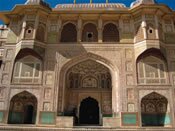
Jaipur’s Amber Fort seamlessly
blends Islamic and Hindu design
Widely regarded to be the best bird sanctuary in Asia, Keoladeo Ghana National Park (otherwise known as Bharatpur), near Agra, is home to more than 350 species of bird, among them painted storks, Indian Saras, egrets and rare Siberian cranes.
10 It’s easy to get the inside track
India is a feast for the senses, but equally, it can be completely overwhelming. And if you’re here for the first time, the risk of making a schoolboy error, like flagging down an ordinary taxi to make the journey from Delhi to Akbar, runs pretty high. You should probably invest in a guide’s services, and they’ll be able to show you best the route round the Golden Triangle.
10 It’s easy to get the inside track
India is a feast for the senses, but equally, it can be completely overwhelming. And if you’re here for the first time, the risk of making a schoolboy error, like flagging down an ordinary taxi to make the journey from Delhi to Akbar, runs pretty high. You should probably invest in a guide’s services, and they’ll be able to show you best the route round the Golden Triangle.
Leave a Reply
